Disclosure: This post was written by Ashish Rai on his blog in 2012, which went on to become #1 voted article in Inbound.org back then. The reason I’m re-publishing it on my blog is I find the process still very relevant today although he hasn’t updated the post since the first publication (so go easy on it).
Last month I read a post on The ROI of SEO by Todd Mintz , where he pretty much outlined the evolving landscape of SEO and what the job of SEOs today really entails if they were to guarantee ROI from their SEO engagement.
Gone are the days where savvy search marketers could “game” the system for their clients and poach high search rankings through technical wizardry. Google’s recent updates have had the effect of “evolving” SEO’s from technical wizards who knew little about marketing into marketers who happen to have technical expertise.
Most of us already know, SEO is becoming increasingly nuanced and SEO today overlaps many disciplines such as User Experience (UX), Conversion Rate Optimization (CRO), Design, Information Architecture (IA) and Social. Given all of these disciplines now merged with SEO — One question that remains to be asked is – Can an SEO by being solely focused on increasing keywords ranking produce ROI?
I guess no. Not anymore.
Don’t get me wrong, I admit rankings is still one of the factors that contribute to ROI. But it’s just. one. of. the. factors, where others include generating productive organic traffic from search, matching query intent with site’s relevance and value proposition.
Today any SEO looking to derive long term value from their SEO engagement need to be able to look at the bigger picture — a look from 10000 feet above into all of these disciplines and know what needs to be done to produce increasing return-on-investment (ROI).
In this post, I will outline an SEO process that embraces all of these disciplines and has literally saved my clients thousands of dollars and countless hours by helping me avoid niches/keywords that offered a lower ROI for the same time and money investment.
So let’s get started, shall we?
1. Pick your head tail, medium tail and long tail keywords wisely
Keyword research can be a tricky job. But do it the right way, and you have pretty much built a strong foundation for your SEO.
I always do my keyword research the scaleable way. Meaning I prioritize sections of the site to conduct keyword research, and then move on with the other section. This way I’m able to focus on a handful of keywords at a time as well as avoid getting burnt out, if I were to do it for the entire site.
Here I will cover one section of a site as part of my keyword research example. Let’s suppose I’m asked to do keyword research for the trekking section of AceTravels (A Travel portal for Nepal). So I’ll first head over to Google Adword Keyword Tool to find keywords that best represent the trekking section for AceTravels.Com.
After some initial keyword research, I found following keywords has the highest search volume. These keywords would be my core terms:

Next, I’ll go ahead and put these keywords into into three different buckets based on their volume. This usually separates out head, body and long tail terms.
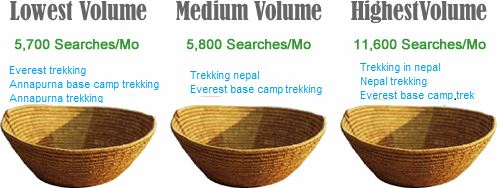
Neil Patel wrote a great post on using semantic keyword research to find supporting terms for your core terms, where he outlined this keyword bucketing process. You can read that post at your own leisure here.
Finally, I’ll head over to UberSuggest (an awesome keyword-expander tool) to find a trend on how people are actually using those core terms, like if they’re adding a suffix or prefix to go with the core terms.

Ubersuggest then returns a list of keywords associated with the provided term. For example, I found the following that are relevant and could be useful, such as:
trekking in nepal [in july, august, september, etc]
[3,4,5,6,7,8] days trekking in nepal
So I pop back to Google Adword Keyword Tool, to find if any of these keywords has any volume, but unfortunately it doesn’t. Yet it makes perfect sense to me to keep them in mind while I go about mapping keywords on the content or perhaps even on the site’s architecture.
2. Kill the head or chase the tail
When optimizing website for quick ROI, the most important step is to identify and capture the low-hanging fruit to begin creating conversions as soon as possible. We do that by chasing your long-tail keywords first, and then your head tail. Meaning we do your optimizing backward.
One common phenomenon around the concept of the long tail of search is the longer the keyword, the closer the prospect is to the buying process.
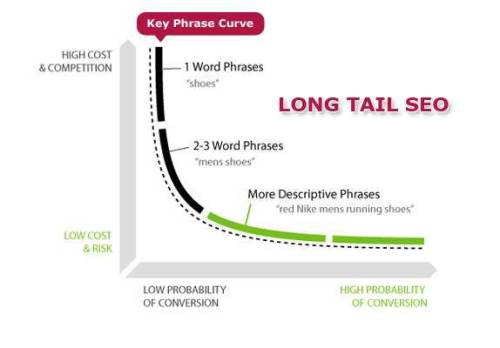
Let me explain the above long tail concept with an example.
Supposing I’m travelling to Nepal for the first time. I’d first initiate my search with “things to do in Nepal” or “places to visit in nepal” and possibly that’s where I’d come know that Nepal’s landscape is an ideal playground for trekking. Assuming that I’m a person who loves to trek, I would then further narrow down my research with “trekking in nepal” or “places to trek in nepal”. But that’s not where I’m gonna pull out my credit card and start making booking/reservation. I’m still researching!
That said, these generic keywords can make money, but people using these keywords are still on a research mode and need more information before they buy your offer. In other words, these are not keywords with commercial intent.
Similarly, if I was able to rank AceTravels for the head term “trekking in nepal”, however the website doesn’t perform well on those targeted long tail keywords like “everest base camp trek.” Then my “trekking in nepal” SERP visibility becomes useless or of little value.
The last statement is a no-brainer for any search marketer yet fewer are actually able to use it to their advantage. On that note, I will leave you with Rand and Will to throw more insights on this exact topic, so I’ll point you over there Keyword Strategies: Kill the Head or Chase the Tail.
Hint: Always go for the exact match.
3. Write smart keyword-rich content.
By smart content, I mean content that is semantic, with right use of images and also videos, if possible. For writing content that is semantic in nature, let Neil teach you How to Create Smarter Content Using Semantic Keyword Research (same post as above)
Another important point to keep in mind while writing content is to write for power skimmers. Steve Krug’s words of wisdom for website usability in his book Don’t Make Me Think applies for all elements of copywriting.
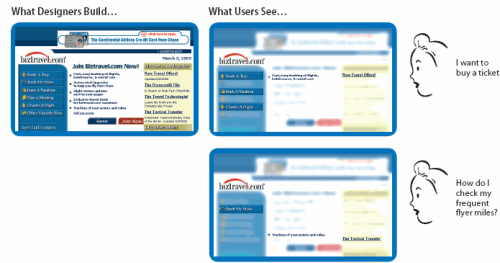
And when you’re rewriting content — make sure you’re mapping the keywords strategically based on the content relevance for maximum impact. Rand did a great whiteboard Friday on this topic, where he walks through the mapping keywords process both into the content and site architecture. You can watch it here.
Following resources are a great place to start writing conversion focused content, which I highly recommend you go through.
The #1 Website Copy Mistake That Most Businesses Make
How Compelling Is Your Website’s Copy? A Simple, 4-Steps Checklist
8 Habits of Conversion Focused Copywriters
4. Build landing pages that converts
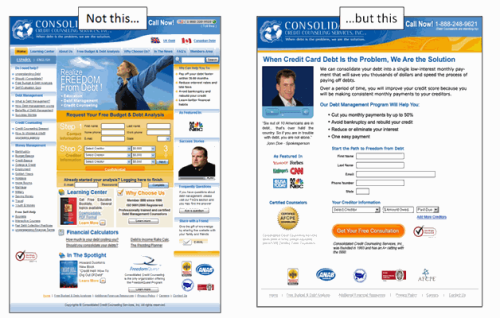
Your landing page pretty much determine your SEO campaign success. I personally devote a big chunk of my time on creating landing pages that converts, optimizing it running A/B and MVT tests time-t0-time. Have to say, I struggle with landing pages like everyone, but there are certain processes that I follow and has helped me a lot. They are pretty simple to start implementing it right away.
It gives me immense pleasure to introduce to you *The Conversion Trinity Path* and it all starts with your landing page answering the following questions:
- Are you relevant to my query? (relevance)
- Do I know why you are the right solution for me? (value)
- Is it obvious what I need to do next? (call-to-action)
In other words, The Conversion Trinity Path= Relevance + Value + Call-to-action. Bryan Eisenberg explained this concept in his key note speech at SESNY earlier this year and @Beebow live blogged about it here.
Here I will expand a little more on the relevance and value part.
Relevance has a very different meaning for a landing page. It’s not you who defines the relevance for a landing page but your visitors. You are just an actor on the landing page’s stage.
Let’s suppose we’re a transportation company and our search ad is showing 20% discount, and the visitor coming to that page from the search ad sees a call-to-action that says “request a free quote” instead of a call-to-action that matches the search ad offer. Here the landing page is too general and do not meet the relevance.
Value also known as value proposition is the primary reason why your ideal prospect should buy from you rather than your competitors.

According to the above conversion sequence/equation by Marketing Experiments, value proposition is the second heavy weight factor on your landing page ( first being the motivation of the user) to help you win conversions.
Sometimes crafting a value proposition can be quite a time-consuming task for which I recommend these 3 worksheets to craft, express, and create derivative value proposition for your landing pages.
4.1. Use images to boost conversions
Have you ever bought anything without ever seeing it? I guess never.
Although a lot been said and written on the web on how to go about using images to boost conversion rate. Yet we often tend to overlook the right use of images when building our website and most importantly our landing page. This is one of the biggest mistakes I used to make during my early days.
And when we say images - it means images that matches with the context. Not just show the product, but show it in context. Let people imagine using it.

I personally think that building landing page is not science, but art (okay, maybe a mix of both). And just like in art or science, you will only get better with a lot of practice/testing.
Oh by the way, I use Unbounce to create my custom landing page designs. You might want to try them out too. No design skills required!
Further resources:
Landing Pages Guide 101: Create Landing Pages that Work
An Introductory Guide to Building Landing Pages (Free Ebook)
50 Ways to Seduce Your Visitors With Persuasive Landing Pages
5. Use Paid search to determine the relative true value of keywords
Sometimes what we see is not what we get! Same applies for keywords, many times your highest volume keyword will turn out to provide the lowest return. On such cases, we cannot wait until we have invested resources and have ranked #1 for such keywords and then realize we have tanked all of our budget on driving unproductive traffic.
Instead we will leverage Paid search to help us determine the true value or the conversion/return from our keywords. Rand covered this idea way back as part of his Head Smacking tips - Using PPC as an indicator of Success.

While you learn from Rand on how to marry paid search with your SEO, I’m hoping to expand a little more and give you few easy things to help you in the watch that you get things right with your PPC campaign.
- Use segmented tracking PPC campaigns to drive traffic to the most relevant landing pages.
- Use exact match keywords.
- Use appropriate budgets for each campaign. Good guide here.
- Write the best PPC ad copy to beat your competitors.
Protip: Run a PPC campaign as soon as you map keywords on a landing page. DO NOT wait for the entire site to be completed.
6. Determine the need for link building using SEO tools
Link building is tough and requires sheer amount of hard work. And then there are cases when we have build and build and build links, and at the end realized that our competitors are beating our 100 links with a single high quality link. What a waste of time and effort!
If SEO is a process so is link building. Therefore, before we build links we need to find out how many links we need to build and more importantly the quality of links we need to build. That said, we don’t want to spend a lot of time with link analyses as there are other important parts that we need concentrate, like outreach. So we will use tools+hustle to speed up the process.

Without further ado, I’d like to introduce you to some of the best free and paid SEO tools I use for competitor backlink analysis and link prospecting.
For competitor’s backlinking analysis
- Use OSE or Ahrefs (or both) to look out for backlink numbers and quality of those links. Consider reading this post on how to check low quality links
- Then use the MajesticSEO Backlink History comparison report. The key here is to look out for competitors’ link growth rate. Are they consistent with their link growth rate or is it a random effort? Once you figure that out, you will know where to hit them and hit ‘em hard!
- The next step is super simple. Run the sites in OSE and download their links into CSV format. You will need SEOmoz Pro account to be able to download those CSVs.
- Use Mozbar Chrome extension to check for Domain Authority (DA) of your competitors. The higher your site’s DA, the easier it is for your website to rank for a keyword.
To determine what kind of links you need
- Head over to Link Detective, (a new tool that categorizes your backlinks into types) and take those competitors you have found and plug them in this tool to see which of their strategies you can easily copy.
- Then run backlink profies of competitor’s in OSE and check their anchor text in Excel using this spreadsheet. Refer to this post on how to use the spreadsheet.
- And then use this spreadsheet to segment your link prospects in three different categories (high level, mid level, and low level). Read this post on how to go about using it. (credit @dohertyjf).
Another great free tool that I recommend for data mining is Distilled’s Microsoft Excel for SEOs. First, it saves you from getting sucked into the vortex of data mining process and second it converts all of those raw data in seconds for you to make actionable insights.
P.S. Serious about doing real SEO s**t? And haven’t started using Excel yet? Here’s a protip: START USING EXCEL TODAY!
7. Build Links!
Came panda. Came penguin or come any of those black and white animal of Big G in the future. Links will continue to be the fuel for SEO. However, building high quality links and a defensible link profile is a must in today’s penguin-era, if we want to remain at the top of our SEO game. Anything less than that is asking for an invitation to something like this on your GWT.

And as long as there are folks like @ipullrank and @jasonacidre in the industry we will never run out of fantastic link building resources like throw your form letters tactics for outreach and conversion-oriented link building strategies using Google Analytics or ideas on building linkable assets - which are all incredible and great!
Ofcourse all of these takes time and while you do all of that, let’s not overlook the low hanging fruits– that is, finding out the unqiue LRDs linking to your competitors, but not to you. And you can easily find those links by using this Excel sheet and then exporting your backlinks from OSE into it and with a little Pivot Table magic…Eureka!
Further resources:
Link Building Strategies – The Complete List
The Noob Guide to Link Building
The 6 Month Link Building Plan for an Established Website
8. Estimate the traffic attainable from various positions
Given the Universal search results with maps, news, videos, images, PPC ads, etc the amount of traffic your site will receive even if you secure the highest organic position—is guaranteed to be skewed. But thanks to the guys over at Sling Shot SEO for coming up with their Google CTR Study Whitepaper: Mission ImposSERPble for us to help determine the click-through rates based on the position.
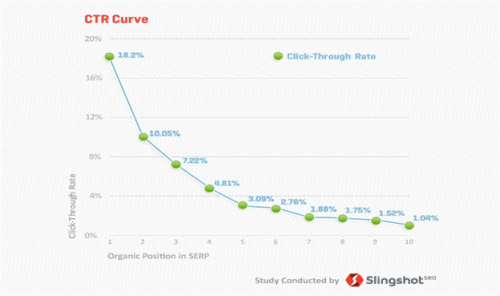
As you can see on the CTR curve above, SlingShotSEO.Com have found that #1 rank will fetch you 18.2% CTR, similarly 10.05% CTR for #2 position, 7.22% CTR for #3 position and below 4% CTR for 5th position and beyond. For more comprehensive review on SERPs CTR rates, I highly recommend you read this SEOmoz post.
And here’s the attainable traffic at #1 position for AceTravels’s travel related keywords we covered above for our Keyword research.
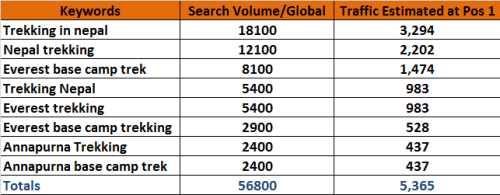
9. Finally, calculate your SEO budget
Now that we have figured out our attainable traffic numbers by positions for the keywords–It’s time to go ahead and craft our SEO budget to maximize ROI.
Assuming that I have already done my homework on competitive analysis and figured out the # of links required to rank for the keywords, content plan and the number of staffs required — I’ve added the cost for ranking, revenue and ROI to the following keywords (I use this spreadsheet developed by @ethanlyon to calculate the ROI).

As you can see above that ROI is the far better indicator than traffic, cost or even revenue–to help you maximize our budget spend. That said, there will be some generic keywords like that of “trekking in nepal” where you won’t be able to apply the variant ROI (as seen above). So you need to break down your generic keywords terms into the longer tail versions and apply a higher average conversion rate on them. This is where paid search data plays a crucial role and will allow you to make better informed decisions.
What that essentially means is, your head term will be the ones to drive a huge chunk of the traffic portion, but it’s the long tail keywords that will each contribute little traffic (and there will be lots of them) yet will be the most profitable set of keywords.
By making sure you are aiming to nail down these most profitable keywords right from the onset of your SEO campaign, will give you a view of getting the right budgets put together as well as the quickest bang for your clients’ buck!
tl:DR SEO that delivers quick ROI is a result of driving productive traffic and capturing them as soon as possible with site relevance and strong value proposition. And being able to measure each of these components by objectives, which in return will result in long-term successful SEO strategy execution.

